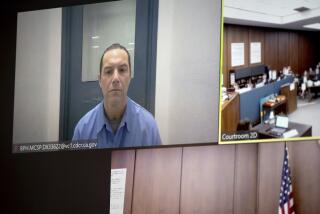Judge OKs 1st Use of DNA Evidence in County Trial
- Share via
A Van Nuys Superior Court judge, climaxing six months of technical debate, ruled Monday that the “genetic fingerprinting” technique has won such widespread scientific acceptance that it can be used for the first time in a Los Angeles County trial.
The ruling by Judge James M. Coleman clears the way for prosecutors to use DNA analysis to prosecute Henry Wilds, 33, on charges of sexually assaulting and robbing two North Hollywood women.
“It is the opinion of this court that by a clear majority of the better-qualified expert witnesses that DNA . . . is generally accepted by the scientific community,” Coleman said.
Under California law, a new scientific technique must be proven reliable and generally accepted by the scientific community to be used in court.
The courts of about 30 states now accept DNA as evidence. In September, a 35-year-old Ventura woman became the first person in California to be convicted with genetic evidence after prosecutors used the DNA patterns in 15 strands of hair as evidence that the woman fatally stabbed a 63-year-old man during an attempted robbery at a Ventura hamburger stand on Feb. 24, 1988.
Prosecutors in Ventura and Alameda counties have won court permission to use the technique in other cases.
Although appeals are pending, no higher court has yet ruled on the technique’s admissibility.
Wilds’ attorney, Ralph J. Novotney Jr., whose client could be imprisoned for up to 53 years if convicted on the 10 counts of rape, robbery, forcible oral copulation and burglary, had challenged use of the technique.
Jury selection is expected to begin soon and the trial is expected to last four to six weeks, Kahn said.
“I feel very bad for Mr. Wilds, but we’re going to have a jury pass on the evidence,” said Novotney, who contended that tests purporting to show Wilds’ culpability in the crimes were based on invalid procedures.
Deputy Dist. Atty. Lisa Kahn, who successfully argued for the admissibility of the DNA evidence, and Novotney agreed that it will be a challenge to present the case to a jury.
“It’s been a lot of work. We’ve had to study molecular biology and genetics,” Kahn said. Novotney agreed, saying that he, Kahn and Coleman all had “struggled with” the intricate scientific concepts.
Coleman had been hearing testimony about the technique sporadically since June from experts that the defense and prosecution flew in from around the country. Several prosecution witnesses were among the top genetic researchers in their field, Novotney and Kahn said.
Developed four years ago in Great Britain, DNA analysis is expected to someday become as important--or perhaps more important-a forensic technique as fingerprinting, both Novotney and Kahn maintain.
DNA, short for deoxyribonucleic acid, is found in all human tissue cells, such as blood, hair, skin and semen. Scientists say DNA can be translated into intricate patterns that resemble supermarket bar codes. Current research indicates that except for identical twins, the chances against two people having identical DNA structure are more than a billion to one.
In genetic fingerprinting, DNA samples taken from evidence at a crime scene are compared to DNA samples taken from a suspect’s blood. The odds are then determined against another individual having the same pattern.
Wilds is accused of assaulting and robbing a 30-year-old woman on Dec. 26, 1986, in the underground garage of her apartment building and of a nearly identical attack on a 27-year-old woman on Feb. 22, 1987.
He was arrested by Los Angeles police in April, 1987, after allegedly following a 28-year-old North Hollywood woman into the underground parking lot of her apartment building.
Over defense objections, prosecutors in the Wilds case got a court order and obtained samples of Wilds’ blood. The DNA pattern was compared to that of semen found in the two victims’ bodies.
Maryland-based Sylmar Diagnostics, which performed the test, said there is an infinitesimal chance that the semen samples did not come from Wilds.
More to Read
Sign up for Essential California
The most important California stories and recommendations in your inbox every morning.
You may occasionally receive promotional content from the Los Angeles Times.













